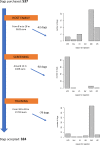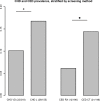Rejections in an non-purpose bred assistance dog population: Reasons, consequences and methods for screening
- PMID: 31194832
- PMCID: PMC6564025
- DOI: 10.1371/journal.pone.0218339
Rejections in an non-purpose bred assistance dog population: Reasons, consequences and methods for screening
Abstract
Assistance dogs aid people with various impairments on a daily basis. To become an assistance dog, a strict selection procedure and intensive training period must be successfully completed. Consequently, not every dog acquired for this purpose, becomes an assistance dog. The purpose of this study was to investigate reasons for failure and the financial consequences thereof for assistance dog associations that do not have a dedicated breeding program for their dogs. Data were collected for a total of 537 dogs enlisted between 2001 and 2015 and purchased out of the general dog population by five Belgian assistance dog associations. Only 60 percent of the dogs actually became an assistance dog and the main reasons for failure were related to undesirable behavioural characteristics and orthopaedic disorders. The estimated average financial loss per rejected dog was found to be 10524 euro. A detailed comparison of the two most popular breeds (Golden Retriever and Labrador Retriever) within the guide dogs and mobility assistance dogs revealed no significant difference in probability of successfully completing the training. However, a comparison of orthopaedic screening methods revealed a higher rejection with computed tomography for elbow dysplasia and laxity-based radiographical techniques for hip dysplasia compared to radiography and the standard ventrodorsal hip extend radiograph alone, respectively. Based on these results, we provide several suggestions to increase the probability of success.
Conflict of interest statement
The authors have declared that no competing interests exist.
Figures


Similar articles
-
Heritabilities and genetic trends for elbow score as recorded by the New Zealand Veterinary Association Elbow Dysplasia Scheme (1992-2013) in four breeds of dog.N Z Vet J. 2018 May;66(3):154-161. doi: 10.1080/00480169.2018.1440652. Epub 2018 Mar 8. N Z Vet J. 2018. PMID: 29457536
-
Impact of sedation method on the diagnosis of hip and elbow dysplasia in Swedish dogs.Prev Vet Med. 2007 Mar 17;78(3-4):196-209. doi: 10.1016/j.prevetmed.2006.10.005. Epub 2006 Nov 16. Prev Vet Med. 2007. PMID: 17112612
-
Genetic evaluation of the total hip score of four populous breeds of dog, as recorded by the New Zealand Veterinary Association Hip Dysplasia Scheme (1991-2011).N Z Vet J. 2015 Mar;63(2):79-85. doi: 10.1080/00480169.2014.961581. Epub 2015 Jan 27. N Z Vet J. 2015. PMID: 25211093
-
Hybrid vigour in dogs?Vet J. 2016 Aug;214:77-83. doi: 10.1016/j.tvjl.2016.05.013. Epub 2016 May 30. Vet J. 2016. PMID: 27387730 Review.
-
Genetics of canine hip dysplasia.J Am Vet Med Assoc. 1997 May 15;210(10):1474-9. J Am Vet Med Assoc. 1997. PMID: 9154200 Review.
Cited by
-
Artificial Selection Drives SNPs of Olfactory Receptor Genes into Different Working Traits in Labrador Retrievers.Genet Res (Camb). 2022 Feb 2;2022:8319396. doi: 10.1155/2022/8319396. eCollection 2022. Genet Res (Camb). 2022. PMID: 35185392 Free PMC article.
-
An overview of the literature on assistance dogs using text mining and topic analysis.Front Vet Sci. 2024 Dec 11;11:1463332. doi: 10.3389/fvets.2024.1463332. eCollection 2024. Front Vet Sci. 2024. PMID: 39723180 Free PMC article. Review.
-
Enhancing the Selection and Performance of Working Dogs.Front Vet Sci. 2021 May 12;8:644431. doi: 10.3389/fvets.2021.644431. eCollection 2021. Front Vet Sci. 2021. PMID: 34055947 Free PMC article. Review.
-
The utilization of the Vezzoni modified Badertscher distension device in breeding programs: Heritability estimates and effect on the hip dysplasia prevalence.PLoS One. 2024 Aug 20;19(8):e0308984. doi: 10.1371/journal.pone.0308984. eCollection 2024. PLoS One. 2024. PMID: 39163383 Free PMC article.
References
-
- Assistance dog international. https://www.assistancedogsinternational.org.
-
- Lane DR, McNicholas J, Collis GM. Dogs for the disabled: Benefits to recipients and welfare of the dog. Appl Anim Behav Sci. 1998;59:49–60.
-
- Rintala DH, Matamoros R, Seitz M. Effects of assistance dogs on persons with mobility or hearing impairements: A pilot study. J Rehabil Res Dev. 2008;45(4):489–504. - PubMed
Publication types
MeSH terms
LinkOut - more resources
Full Text Sources

